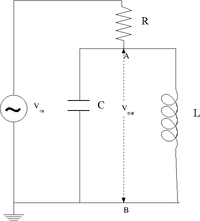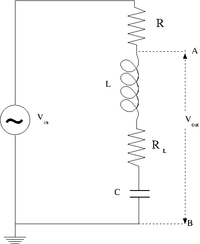Lab 5 TF EIM
LC Resonance circuits
The LC cicuit
- Design a parallel LC resonant circuit with a resonant frequency between 50-200 kHz. use = 10 - 100 , R = 1k .
- Construct the LC circuit using a non-polar capacitor
- Measure the Gain as a function of frequency. (25 pnts)
- Compare the measured and theoretical values of the resonance frequency () (10 pnts)
Questions
- What is the bandwidth of the above circuit? (5 pnts)
From the plot above we have
The bandwidth defined as the width from to where the amplitude of signal drop down to . At this point . Let's plot this line and calculate the bandwidth.
The RLC cicuit
- Design and construct a series LRC circuit.
- Measure and Graph the Gain as a function of the oscillating input voltage frequency. (25 pnts)
- Measure and Graph the Phase Shift as a function of the oscillating input voltage frequency. (25 pnts)
Questions
- What is the current at resonance? (5 pnts)
- What is the current as ? (5 pnts)

